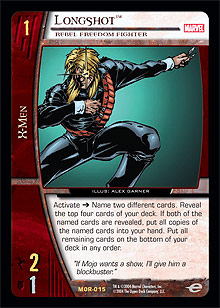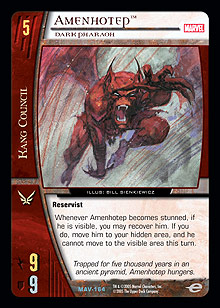
The title of this week’s article is taken directly from Kang himself. He was threatening the Avengers like that in 1974, and now he has his sights set on Vs. System.
 Let’s start today’s risky foray with a look ahead to a Golden Age format that includes the Avengers set. Since I always begin my study of a new set by looking for Longshot targets, Kang demands my immediate attention. We have never seen one Vs. System character with so many different versions. Not only does this allow massive potential for powering up a Kang in play, it also makes Longshot start dreaming of time travel.
Let’s start today’s risky foray with a look ahead to a Golden Age format that includes the Avengers set. Since I always begin my study of a new set by looking for Longshot targets, Kang demands my immediate attention. We have never seen one Vs. System character with so many different versions. Not only does this allow massive potential for powering up a Kang in play, it also makes Longshot start dreaming of time travel.
Since the comic book myths of Kang follow him through many different time periods and power phases, he is represented in Vs. System by at least one version at each cost from 1 through 8. Kang is not unique, and therefore our lucky little mutant Longshot can fill a hand with playable character cards for every turn. Kang functions as the most powerful army character ever introduced to Vs. System, even though he is not an actual army character.
There are eleven different versions of the evil time traveler, so you will need to decide which Kang abilities serve your personal play style best. Kang, The Conqueror is a control player’s dream. Kang, Kang Kong allows any single card to be fetched from the deck. Kang, Lord Kang uses his leader ability to make an unstunnable attack force from the power-up potential of multiple Kangs in hand.
Avengers did not bring many new army characters into the card pool, but Macrobots has so much risky promise that it might make up for it. One copy of Macrobots could swell to outrageous size by exhausting a swarm of small characters from any team affiliation. If the weenie support for Macrobots is provided by Fantastic Four characters, Cosmic Radiation could help the game to end before turn 6. Press the Attack could seal the deal for the Kang-created power-absorbing machine. A Child Named Valeria could extinguish opposing Flame Traps. If the opponent gets Blind Sided by a huge swing from our Macrobots, victory will be unexpectedly swift.
 Before we get ahead of ourselves in Macrobots strategy, let’s go back in time and reveal their origin myth. The year was 1974. The comic book was “Avengers #129.” Kang had traveled back to the twentieth century to take over the world. The Avengers caught wind of Kang’s evil plan and engaged him in battle. Our heroes found out quickly that Kang had created some powerful new weapons called Macrobots. These robots were unlike any enemy The Avengers had ever faced.
Before we get ahead of ourselves in Macrobots strategy, let’s go back in time and reveal their origin myth. The year was 1974. The comic book was “Avengers #129.” Kang had traveled back to the twentieth century to take over the world. The Avengers caught wind of Kang’s evil plan and engaged him in battle. Our heroes found out quickly that Kang had created some powerful new weapons called Macrobots. These robots were unlike any enemy The Avengers had ever faced.
The Macrobots absorbed any attacks that were directed against them. When Scarlet Witch shot off a hex beam at one of Kang’s evil toys, it simply made the machine stronger on the counterattack. The Macrobots could also use living beings as power sources—the stronger the character trapped inside them, the stronger the Macrobots became. Kang planned this ability as a specific strategy against The Avengers, and it worked very well.
The Avengers were defeated soundly by three of Kang’s Macrobots. Kang imprisoned Thor, Iron Man, and Vision inside the evil machines. The super-powered Macrobots were then sent out into the world to start World War III. One Macrobot was directed to kill the U.S. Secretary of State, one was sent to destroy the Prime Minister of Russia, and the third left on a mission to assassinate the Premiere of China.
The female Avengers had been taken as prisoners, but Kang allowed Swordsman to go free since he was considered too weak to be a threat to the evil plan. Swordsman saved the day by awakening Rama-Tut, who was revealed to be Kang himself in the future. While in Egypt, Swordsman became a wanted man because he was invading tombs to find Rama-Tut. Egyptian soldiers were about to capture the Avenger when a future Vs. System superstar was introduced—Amenhotep was released from a pyramid and proceeded to devour the entire army.
The Avengers won the final battle against the Macrobots and Kang did not destroy the entire world. In the process, two very powerful characters were created to survive into the future. Now we get to use them in our risky Vs. System strategies.
 We have already covered Macrobots, so we can turn our attention to Amenhotep. This character is extremely strong in Sealed Pack, and it looks to be a killer in Constructed, as well. Amenhotep’s ability reminds me of Nimrod’s—they are both very difficult to remove from play. My first goal for Amenhotep is to devise a risky strategy that allows him to attack twice on the fifth turn. I also want to use Cosmic Conflict on the second attack. To accomplish this trick, Amenhotep will need to ready after he recovers and moves to the hidden area. Readying a character to attack again is a very powerful ability that is reserved for only a few cards. I will leave it to you to discover how it can be done.
We have already covered Macrobots, so we can turn our attention to Amenhotep. This character is extremely strong in Sealed Pack, and it looks to be a killer in Constructed, as well. Amenhotep’s ability reminds me of Nimrod’s—they are both very difficult to remove from play. My first goal for Amenhotep is to devise a risky strategy that allows him to attack twice on the fifth turn. I also want to use Cosmic Conflict on the second attack. To accomplish this trick, Amenhotep will need to ready after he recovers and moves to the hidden area. Readying a character to attack again is a very powerful ability that is reserved for only a few cards. I will leave it to you to discover how it can be done.
Speaking of you, it is time now to talk about a few ideas submitted by my risky readers!
Paul “TheDerangedBear” Sung from Games of Berkeley informs me:
Avengers Assemble = Bananas with army characters.
Thanks, Paul. You are absolutely correct. This is surely the reason why there are only two new army characters in the set, and it has me dreaming and scheming about ways to team up Wild Sentinels with Avengers. Anyone who feels like getting risky with me is welcome to report any progress in this area.
Paul “Objulen” has a nasty control combo that he reported in response to my “Free Lunch” article. He writes:
I play a Doom/X-Men stall deck that I recently made into more of a New
School deck than anything else (to the point of replacing two of my
Unlikely Allies with Forced Allegiance, which also helps satisfy Dr.
Doom’s plot twist blocking). Using Dr. Light, Puppet Master, and
Devil’s Due, I can pump my 4-cost Dr. Doom and get an extra exhaust in.
See Paul, that’s why I need readers like you. I do not play control or stall decks myself and I would never have thought of using Dr. Light, Master of Holograms to allow Puppet Master to activate twice per turn. That is really sick and really good. I suggest adding a few other self-KO effects, and I hope you will shoot for three Puppet Master activations per turn by recruiting him twice. Thanks.
Finally, Mike Lawson has an impeccable method for getting an edge on the DC Modern metagame. Mike thoroughly deconstructed the top decks from Pro Circuit Indianapolis and the recent DC Modern PCQs. I found it fascinating to see such a meticulous study, and it helps me personally to analyze the obstacles that my risky strategies must overcome. Today’s article has rambled long enough, so I will bid you goodbye now and save the actual statistics for next week. See you back here next Monday. Stay risky!
Rian Fike is also known as “stubarnes” in the VsRealms community. If you have questions, comments, or a risky strategy that you would like him to cover in a future article, drop him a line at rianfike@hattch.com.